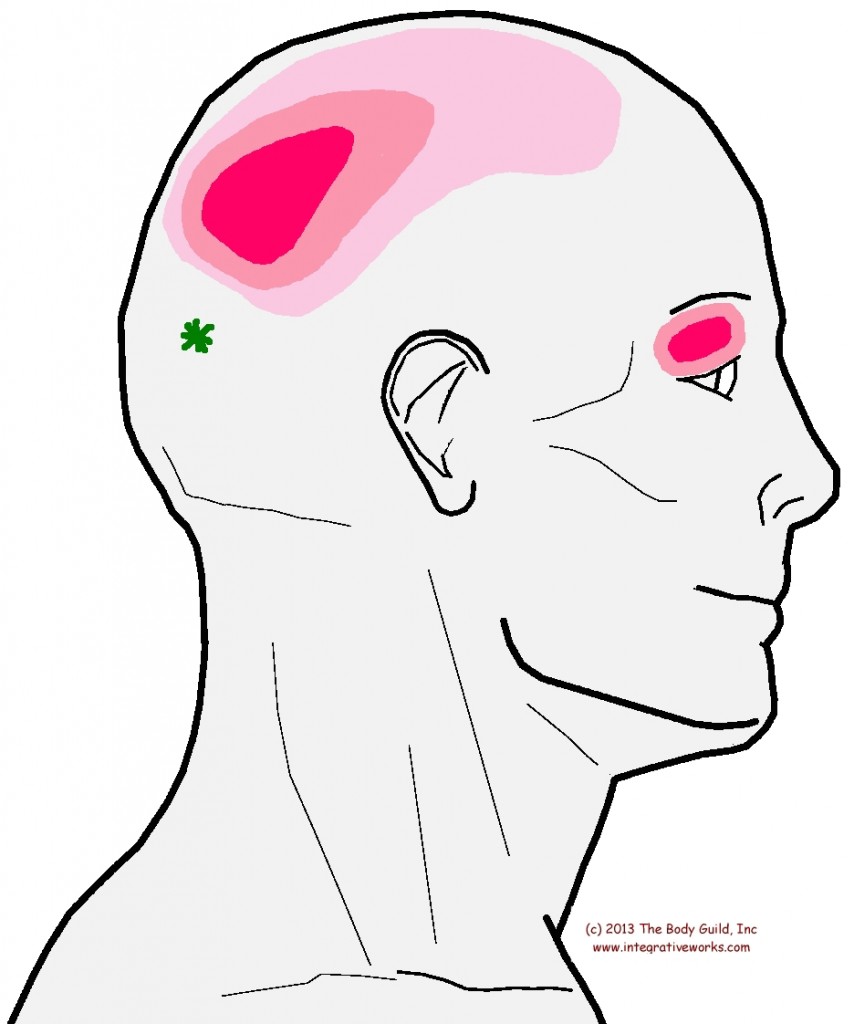Headache Beside Crown with Achy Eye Pain
Table of Contents
- How People Describe This Pain Pattern
- How You Activate and Intensify This Pain Pattern
- Self-Care – Getting Relief on Your Own
- Musculoskeletal Anatomy Behind Your Pain
- Therapy Notes for Massage and Bodywork
Want to skip ahead?
Here’s a link to my post about
getting relief on your own.
How People Describe This Pain Pattern


People complain of an intense headache that makes their eyes hurt. When I ask them about other areas of pain, they will describe the headache near the top of their head but make a gesture to the back of their head beside the crown. They usually focused on eye pain and say that it makes their eyes hurt. On the other hand, headaches, like this one, seem to pinpoint in the back of the eye.
Tired Eyes
At times, they complain about achy, tired eyes. Often, they associate it with visual strain. In those cases, they complain of things like bright lights, hours of study, or small print. For example, if they wear a hat, they often wear it loosely or complain that it creates a headache or makes their eyes hurt. One client refers to it as “crazy eyes.” She wears a loose baseball cap almost all the time. She says that the bill blocks the light, but the hat is not tight enough to create a headache.
How You Activate and Intensify This Pain Pattern
Ryan Braun shows off his occipitalis muscle.
This muscle shifts the hair back, lifting the eyebrows without wrinkling the forehead to create that look of reflective disappointment. When this headache is acting up, this motion increases the pain. But, of course, you’d have to be a clown or have a lot of disappointing conversations to create these headaches through over-use of the occipitalis.
Bump or Squeeze
Most often, this trigger point usually is activated through physical pressure. For example, this might include pressure from a hat, laying your head on something hard, or bumping the back of the head on a cabinet. However, once this is aggravated, even things that normally don’t bother you, like the pressure of the tip of the stem on your sunglasses, can irritate this.
Occasionally, it is a satellite trigger point from the referral of trigger points in the neck.
The Musculoskeletal Anatomy Behind Your Pain
Musculoskeletal Anatomy
This is a flat muscle behind the ear that raises the eyebrows. You can read more about it in this post on the anatomy of occipitalis.
Getting Relief on Your Own
Clinically Proven
Self-Care Strategies
Take a look at this post for what you may be doing to perpetuate this problem and some easy, effective strategies for getting rid of the pattern.
Therapy Notes for Massage and Bodywork
Better Bodywork
Through Shared Expertise
This post has techniques, tips, treatment routines, and anatomy illustrations to improve the bodyworker’s approach.
Support Integrative Works to
stay independent
and produce great content.
You can subscribe to our community on Patreon. You will get links to free content and access to exclusive content not seen on this site. In addition, we will be posting anatomy illustrations, treatment notes, and sections from our manuals not found on this site. Thank you so much for being so supportive.
Cranio Cradle Cup
This mug has classic, colorful illustrations of the craniosacral system and vault hold #3. It makes a great gift and conversation piece.
Tony Preston has a practice in Atlanta, Georgia, where he sees clients. He has written materials and instructed classes since the mid-90s. This includes anatomy, trigger points, cranial, and neuromuscular.
Question? Comment? Typo?
integrativeworks@gmail.com
Interested in a session with Tony?
Call 404-226-1363
Follow us on Instagram
*This site is undergoing significant changes. We are reformatting and expanding the posts to make them easier to read. The result will also be more accessible and include more patterns with better self-care. Meanwhile, there may be formatting, content presentation, and readability inconsistencies. Until we get older posts updated, please excuse our mess.